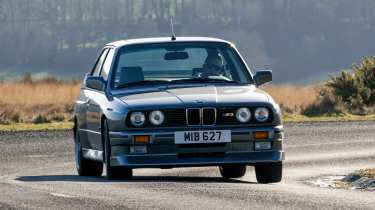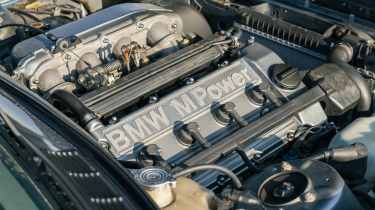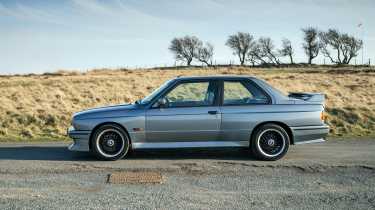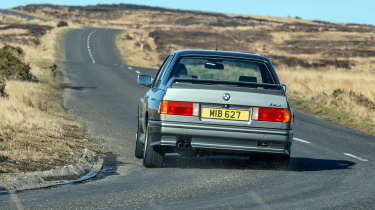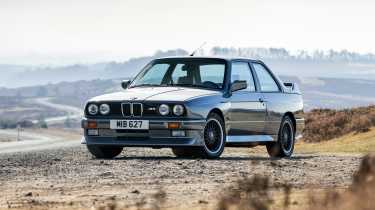BMW M3 (E30, 1986-1990) review – the greatest M car of all?
The E30 BMW M3 fully deserves its legendary status, born from racing and still delivering a knock-out drive four decades on from its launch
Today we take BMW’s M cars almost for granted, but back in the mid-’80s the company’s motorsport division had put its initial on just three road-going models: the M1 supercar, the similarly-engined M635CSi and the mildly tweaked M535i. Yet while each of these cars intrigued and impressed, none of them would be talked about as much as the road car that would follow: the E30 M3.
The original M3 is nothing short of an icon; a true homologation special with racing provenance and a driving experience to back it up. It’s a car defined by motorsport but also its usability, quality and the sheer enjoyment it can deliver on the road, setting the template for the generations of M3 that followed. Some would say none of those subsequent models have bettered it, and that’s reflected in today’s values. Early models have now risen to over £50k, with the best Sport Evolution examples costing £150k. Big money, but then the E30 is an inimitable car – as we’ve been reminded each time we’ve driven one at evo.
BMW E30 M3 history and specs
Although designed primarily to take on BMW’s rivals on the race track, amongst them Mercedes-Benz’s rally car turned DTM racer, the Cosworth-powered 190E 2.3-16, the public would get to experience the M3 too, as the Group A rules of the time specified that 5000 road-legal examples of the car would have to be built in its first 12 months of production for it to be homologated for competition use.
More reviews
Group tests
In-depth reviews
- BMW 3-series 2025 review – does it still reward the keen driver?
- BMW M3 Competition (G80) review – the best M3 in generations
Review
Reviews
The core of the M3 would be its engine, but rather than choosing a more powerful six-cylinder unit as a starting point, Paul Rosche, then technical director of BMW M GmbH, opted for a high-output four-cylinder, not only to save weight, but also because it would be able to rev higher (the six-cylinder engine’s crank suffered from vibrations at mid- to high-revs).
The new engine was based on the iron block from BMW’s production 2-litre four (which could trace its roots back to the BMW 1500 of the 1960s) but with a long-stroke crankshaft and an increased bore resulting in a larger 2302cc capacity. Mated to this was a shortened version of the four-valves-per-cylinder head taken from the M1 and M635CSi, equipped with Bosch Motronic fuel injection. In final production form it produced 200bhp at 6750rpm (195bhp with the optional catalytic converter at the time), with a rev limit of 7300rpm. In competition trim 300bhp and even higher revs would be attainable. Amazingly, the first prototype engine would take just 14 days to get up and running, hence the unit’s ‘S14’ designation.
The M3 was also fitted with Getrag close ratio five-speed dog-leg gearbox, while a limited-slip differential would help to transfer the power to the rear wheels. Handling was improved over the stand E30 models with uprated springs, new Boge dampers (an electronically adjustable set-up would later be an option), thicker anti-roll bars and an increased caster angle on the front suspension to improve stability and steering response. Behind new five-stud 15in BBS alloys were the stronger stub axles and wheel bearings from the 528i, plus upgraded brakes (280mm vented discs at the front, 282mm solid ones at the rear) with a Bosch ABS system.
While the M3 shared its basic shape with the stock E30, all the panels bar the bonnet and doors were bespoke. The wings were flared to accommodate the larger wheels required for motorsport, the angle of the rear screen was reduced and a higher bootlid adopted to improve airflow to the new rear spoiler, while the front and rear bumpers were changed to match the new wings and provide further aerodynamic assistance. The result was a drag coefficient reduced from 0.38 to 0.3.
A prototype M3 was shown at the Frankfurt motor show in September 1985 and production started a year later, not at the M Division’s Garching factory but, because of the large number of cars that needed to be built in a short space of time, at BMW’s Munich-Milbertshofen plant.
The M3 went on sale in the UK in early 1987 priced at £22,750 – some £6000 more than a 325i Sport and just £2500 shy of a Porsche 944S. Not cheap, but then it would receive universal praise from the motoring press, while over the following years the racing version would win the German, British, Italian, European and World Touring Car championships, many of them more than once.
By the time production ended in 1991, nearly 18,000 M3s had been built (including three small runs of different ‘Evolution’ versions, each created to homologate further modifications). This success would pave the way for many more M cars, all of them more powerful, most of them excellent drivers’ cars too. But the E30 still holds up today as an exciting, richly involving road racer that in many ways is BMW’s definitive M car.
Driving it
Peter Tomalin, evo issue 334
“The Evolution formed the basis for the Roberto Ravaglia Edition, which arrived just as the decade was closing, built to celebrate the Italian’s multiple championship wins. It was essentially an Evo with special trim, black-painted wheels and a numbered plaque. Peak power was 212bhp at 6750rpm, with 170lb ft at 4600, both down slightly on the Evo due to the fitment of a catalyst. Only 25 were offered in the UK and all were immediately snapped up at a price of £26,850.
“The example we’re testing belongs to BMW UK’s heritage fleet and it’s absolutely pristine; it even smells like a new car in that typically ’80s/90s slightly perfumey BMW way. And it’s clear the Bavarians had got a proper handle on ergonomics by this stage; everything is just where you’d expect it to be if you came straight from a modern car. Except perhaps first gear, which is on a dogleg.
“This Ravaglia Edition has done 85,000 miles, but you’d never know. It feels drumskin-tight and rattle-free, and it covers the ground beautifully. A little gutless compared with a contemporary Audi Quattro but with a greater sense of poise and control, the steering a touch light but pleasingly precise. In fact with the plush interior and so much precision and poise, the M3’s almost too polished in this company – from the image and the racing pedigree, you’d be forgiven for expecting something a bit more raw, visceral – and after my first stint I confess I climb out impressed but not wowed.
“My colleagues are understanding. ‘You have to take it by the scruff,’ says evo editor-at-large John Barker. ‘It’s still not very quick, but then the chassis really starts to work and it’s beautifully poised. That’s where all the speed is.’ Deputy editor James Taylor describes it as ‘one of the most neutral cars I’ve driven in a long time: no understeer, no oversteer unless you really go out of your way to unsettle it.’
“evo founder Harry Metcalfe, who owned E30 M3s back in the day, is reliving very happy memories. ‘It’s lovely to get back in a really fit M3,’ he smiles. ‘It feels great on these roads. You have to rev it out, but it’s worth it because these later cars had a little extra sparkle at the top end.’
“The next morning I spend more time with the M3, revving it right out to glean every last horsepower and uncover more of the racer’s edge. Yes, it would be more exciting with more power, but as with so many of the cars of this era it’s not about outright performance, it’s about carrying speed; composure; feeling connected. It’s a precision tool and totally absorbing.”
BMW E30 M3 values
Unsurprisingly, the E30 M3’s combination of racing pedigree, driving involvement and quality (not to mention those box arches…) make it an extremely desirable car, which is reflected in the market. Standard examples tend to change hands for over £50k, even with over 100,000 miles on the clock and non-original parts and modifications.
At the opposite end of the spectrum is the Sport Evolution, the pinnacle of E30s. Just 600 were produced, and being the most powerful variant (thanks to an enlarged 235bhp 2.5-litre four-cylinder engine), they sit in another stratosphere for price. You’ll need upwards of £120k for a well maintained – if high mileage – car. The tidiest examples, meanwhile, can fetch £150k.
